<< Previous | Displaying results 151-199 of 1275 for "Liberation" | Next >>
The 95th Infantry Division participated in major WWII campaigns and is recognized for liberating Werl, a prison and civilian labor camp, in 1945.
The 8th Armored Division participated in major WWII campaigns and is recognized for liberating the Halberstadt-Zwieberge subcamp of Buchenwald in 1945.
The 8th Infantry Division participated in major WWII campaigns and is recognized for liberating the Wöbbelin subcamp of Neuengamme in 1945.
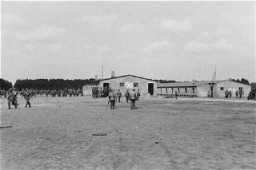
The 20th Armored Division participated in major WWII campaigns and is recognized for liberating the Dachau concentration camp in 1945.
The 101st Airborne participated in major WWII campaigns and is recognized for liberating the Kaufering subcamp of Dachau in 1945.
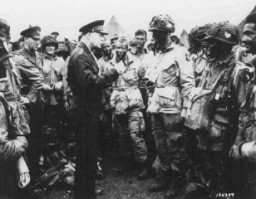
The 99th Infantry Division participated in major WWII campaigns and is recognized for liberating subcamps of the Dachau concentration camp in 1945.
The 103rd Infantry Division participated in major WWII campaigns and is recognized for liberating a subcamp of Kaufering in 1945.
The 104th Infantry Division participated in major WWII campaigns and is recognized for liberating the Dora-Mittelbau concentration camp in 1945.
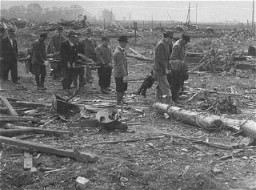
The 63rd Infantry Division participated in major WWII campaigns and is recognized for liberating several of the Kaufering subcamps of Dachau in 1945.
The 82nd Airborne Division participated in major WWII campaigns and is recognized for liberating the Wöbbelin subcamp of Neuengamme in 1945.
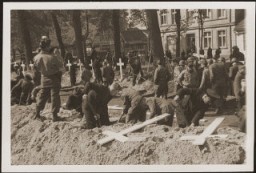
The 65th Infantry Division participated in major WWII campaigns and is recognized for liberating a subcamp of Flossenbürg in 1945.
The 45th Infantry Division participated in major WWII campaigns and is recognized for liberating the Dachau concentration camp in 1945.
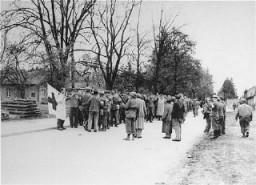
The 42nd Infantry Division participated in major WWII campaigns and is recognized for liberating the Dachau concentration camp in 1945.
The 36th Infantry Division participated in major WWII campaigns and is recognized for liberating some of the Kaufering subcamps of Dachau in 1945.
The 29th Infantry Division participated in major WWII campaigns and is recognized for liberating Dinslaken, a civilian labor camp, in 1945.
The 69th Infantry Division participated in major WWII campaigns and is recognized for liberating the Leipzig-Thekla subcamp of Buchenwald in 1945.
The 71st Infantry Division participated in major WWII campaigns and is recognized for liberating the Gunskirchen subcamp of Mauthausen in 1945.
The 80th Infantry Division participated in major WWII campaigns and is recognized for liberating Buchenwald and the Ebensee subcamp of Mauthausen in 1945.
The 12th Armored Division participated in major WWII campaigns and is recognized for liberating a subcamp of Dachau in 1945.
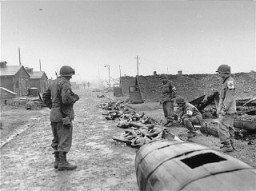
The German town of Hadamar housed a psychiatric clinic where almost 15,000 men, women, and children were killed between 1941 and March 1945 in the Nazi Euthanasia Program.
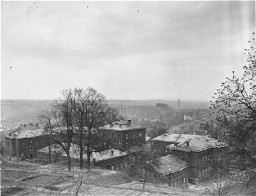
The 3rd Armored Division participated in major WWII campaigns and is recognized for liberating the Dora-Mittelbau concentration camp in 1945.

The 4th Armored Division participated in major WWII campaigns and is recognized for liberating the Ohrdruf subcamp of Buchenwald in 1945.
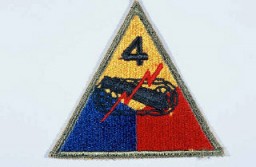
As a US Army sergeant, Raymond fought in the Battle of the Bulge. In May 1945, his unit was deployed to the Mauthausen camp in Austria to bulldoze mass graves for the victims. He watched as German civilians, on US orders, hauled bodies to the mass graves. He also saw stronger camp survivors pull clothes off their weaker counterparts to replace their own tattered uniforms. Raymond went on to Mauthausen's Ebensee camp and Gusen, guarding SS men.
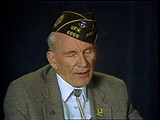
Tarmo Holma is a veteran of the 11th Armored Division. During the invasion of German-held Austria, in May 1945 the 11th Armored (the "Thunderbolt" division) overran two of the largest Nazi concentration camps in the country: Mauthausen and Gusen.
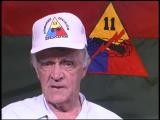
Ross Snowdon is a veteran of the 11th Armored Division. During the invasion of German-held Austria, in May 1945 the 11th Armored (the "Thunderbolt" division) overran two of the largest Nazi concentration camps in the country: Mauthausen and Gusen.
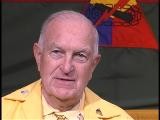
A survivor in Wöbbelin. The soldier in the foreground of the photograph wears the insignia of the 8th Infantry Division. Along with the 82nd Airborne Division, on May 2, 1945, the 8th Infantry Division encountered the Wöbbelin camp. Germany, May 4-5, 1945.
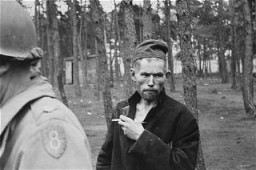
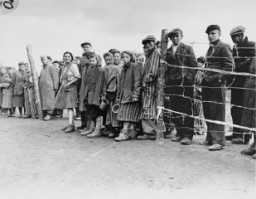
The Ohrdruf camp was a subcamp of the Buchenwald concentration camp, and the first Nazi camp liberated by US troops.
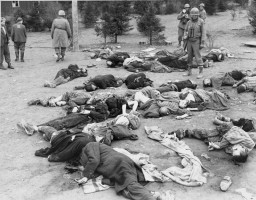
The 4th Infantry Division participated in major WWII campaigns and is recognized for liberating the Haunstetten subcamp of Dachau.
At the Kaufering complex, part of the Dachau camp system, prisoners were forced to labor under brutal conditions to build underground facilities for German fighter aircraft production.
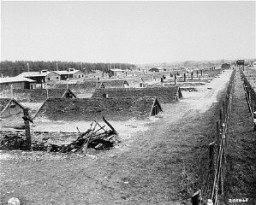
Darrell Romjue is a veteran of the 11th Armored Division. During the invasion of German-held Austria, in May 1945 the 11th Armored (the "Thunderbolt" division) overran two of the largest Nazi concentration camps in the country: Mauthausen and Gusen.
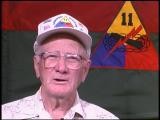
A pile of corpses in the newly liberated Dachau concentration camp. Dachau, Germany, April 29-May 1945. This image is among the commonly reproduced and distributed, and often extremely graphic, images of liberation. These photographs provided powerful documentation of the crimes of the Nazi era.
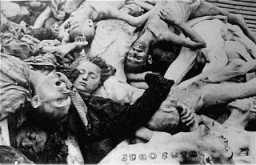
View of a watchtower and prisoner barracks at the Ohrdruf subcamp of the Buchenwald concentration camp, soon after US forces liberated Ohrdruf. Ohrdruf, Germany, April 1945.
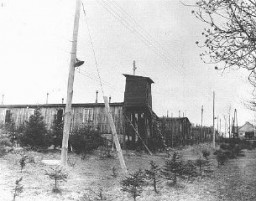
The bodies of former prisoners are laid out in rows in preparation for burial in the Ohrdruf concentration camp. Ohrdruf, Germany, April 1945.
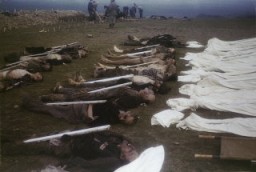
View of a mass grave in the Ohrdruf concentration camp from which 2,000 corpses were removed for proper burial. Ohrdruf, Germany, between April 20 and 25, 1945.
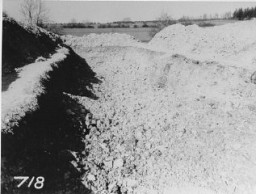
The main gate of the Wöbbelin concentration camp. On May 2, 1945, the 8th Infantry Division and the 82nd Airborne Division encountered the Wöbbelin concentration camp. Photograph taken upon the liberation of the camp by US forces. Germany, May 4, 1945.
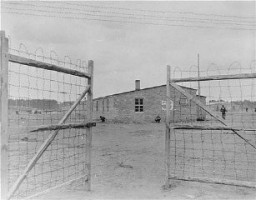
Insignia of the 82nd Airborne Division. The nickname for the 82nd Airborne Division originated in World War I, signifying the "All American" composition of its members. The troops who formed the division came from diverse areas of the United States.
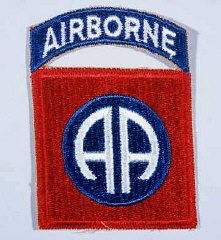
View of the Flossenbürg concentration camp after the liberation of the camp by US forces. Flossenbürg, Germany, 1945.

Execution site in the Flossenbürg concentration camp, seen here after liberation of the camp by US armed forces. Flossenbürg, Germany, after May 1945.
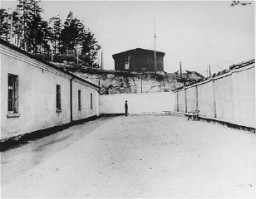
Insignia of the 80th Infantry Division. The nickname of the 80th Infantry Division, the "Blue Ridge" division, reflects the home states of the majority of soldiers who formed the division during World War I: Pennsylvania, West Virginia, and Virginia. The Blue Ridge Mountains run through these three states.
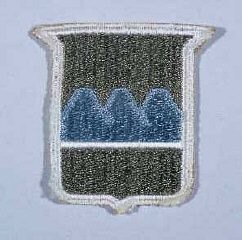
View of the Mauthausen concentration camp. This photograph was taken after the liberation of the camp. Austria, May 5-30, 1945.
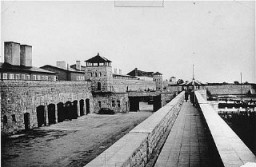
Emaciated survivors of the Mauthausen concentration camp soon after the liberation of the camp. Austria, May 1945.
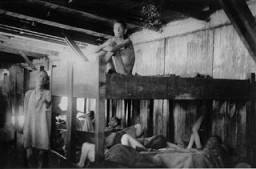
A view of the Buchenwald concentration camp after the liberation of the camp. Buchenwald, Germany, after April 11, 1945.
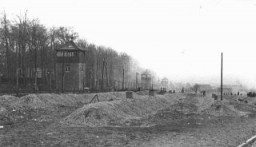
A view of barracks in the Buchenwald concentration camp. This photograph was taken after the liberation of the camp. Buchenwald, Germany, after April 11, 1945. Buchenwald, along with its subcamps, was one of the largest concentration camps established within the old German borders of 1937.
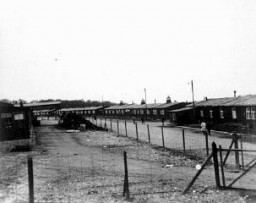

Insignia of the 30th Infantry Division. The nickname of the 30th Division was Old Hickory, named after President Andrew Jackson.
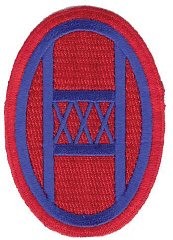
Shortly after liberation, an emaciated concentration camp inmate stands between two members of the International Red Cross. Theresienstadt, Czechoslovakia, May 1945.
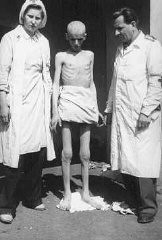
Zyklon B pellets found at the liberation of the Majdanek camp. Poland, after July 1944.

Liberated prisoners demonstrate the overcrowded conditions at the Buchenwald concentration camp. Photograph taken after the liberation of the camp. Buchenwald, Germany, April 23, 1945.
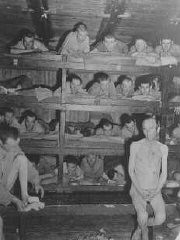
We would like to thank Crown Family Philanthropies, Abe and Ida Cooper Foundation, the Claims Conference, EVZ, and BMF for supporting the ongoing work to create content and resources for the Holocaust Encyclopedia. View the list of donor acknowledgement.